Marks & Spencer: Roles, Theories and Operational Management Report
VerifiedAdded on 2020/06/03
|15
|4111
|48
Report
AI Summary
This report provides an in-depth analysis of management and operations within Marks & Spencer. It begins by defining the roles and characteristics of leaders and managers, contrasting their responsibilities and attributes. The report then examines the roles of leaders and managers in various organizational contexts, such as conflict resolution, human resource management, and globalization, highlighting the importance of communication, facilitation, and decision-making. Different leadership theories, including trait theory, contingency theory, and situational leadership, are explored, along with their applicability in modern business environments. Furthermore, the report delves into key approaches to operations management, emphasizing the selection of resources, processing mechanisms, and the use of standard operating procedures and quality control measures. The roles of managers and leaders in human resource management, decision-making, and capacity management are also discussed. The report underscores the significance of operational management in achieving business objectives and concludes by considering factors that influence decision-making in operational management, offering a comprehensive overview of Marks & Spencer's operational strategies.
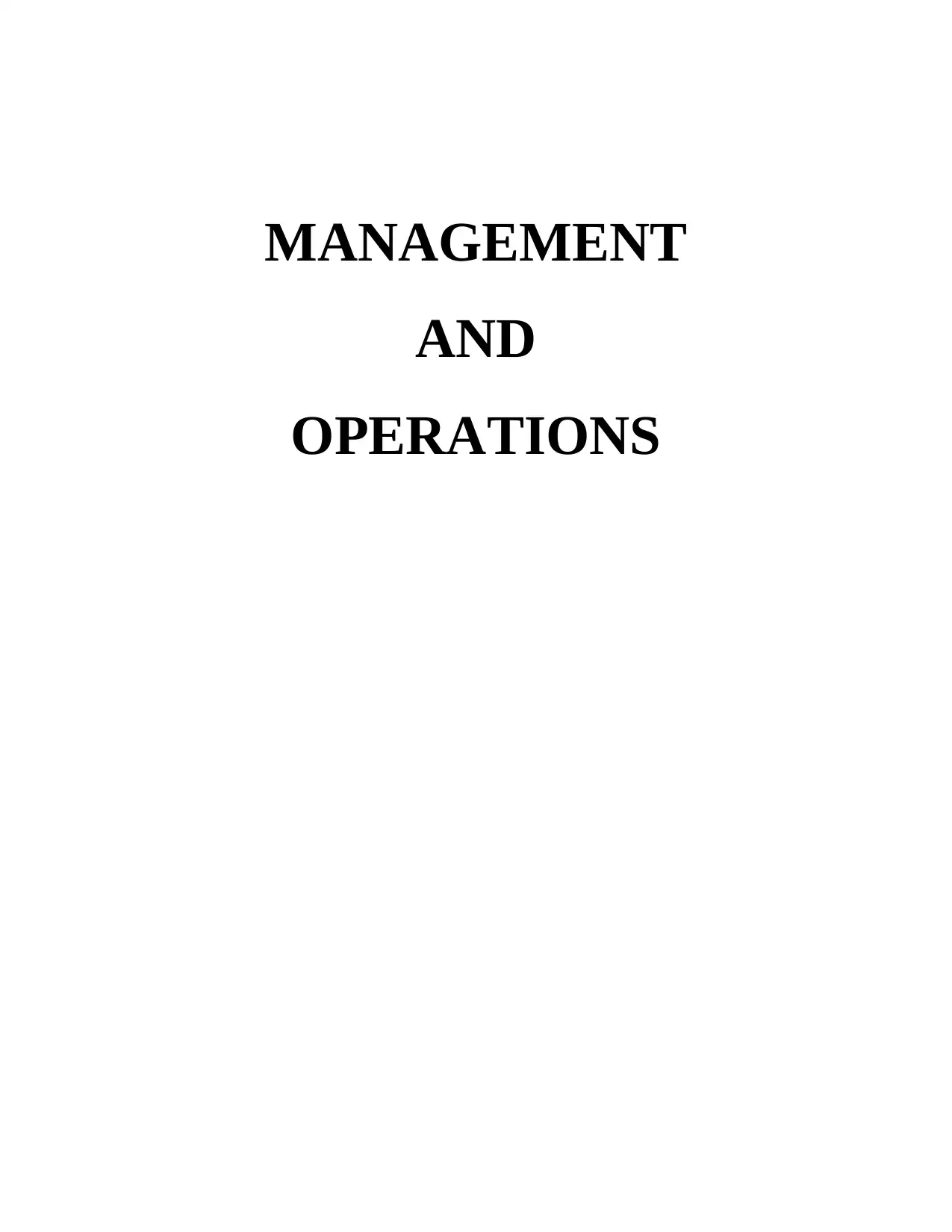
MANAGEMENT
AND
OPERATIONS
AND
OPERATIONS
Paraphrase This Document
Need a fresh take? Get an instant paraphrase of this document with our AI Paraphraser
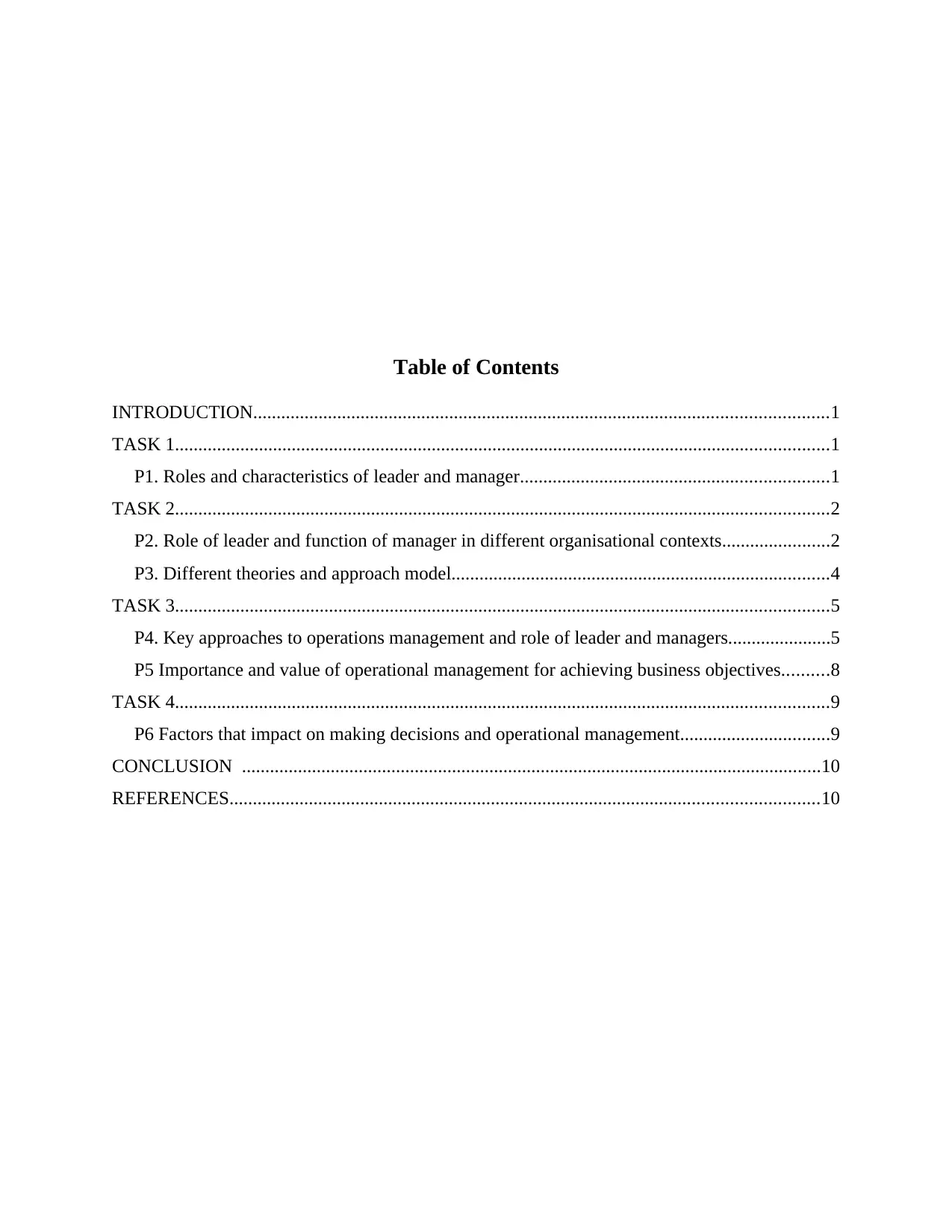
Table of Contents
INTRODUCTION...........................................................................................................................1
TASK 1............................................................................................................................................1
P1. Roles and characteristics of leader and manager..................................................................1
TASK 2............................................................................................................................................2
P2. Role of leader and function of manager in different organisational contexts.......................2
P3. Different theories and approach model.................................................................................4
TASK 3............................................................................................................................................5
P4. Key approaches to operations management and role of leader and managers......................5
P5 Importance and value of operational management for achieving business objectives..........8
TASK 4............................................................................................................................................9
P6 Factors that impact on making decisions and operational management................................9
CONCLUSION ............................................................................................................................10
REFERENCES..............................................................................................................................10
INTRODUCTION...........................................................................................................................1
TASK 1............................................................................................................................................1
P1. Roles and characteristics of leader and manager..................................................................1
TASK 2............................................................................................................................................2
P2. Role of leader and function of manager in different organisational contexts.......................2
P3. Different theories and approach model.................................................................................4
TASK 3............................................................................................................................................5
P4. Key approaches to operations management and role of leader and managers......................5
P5 Importance and value of operational management for achieving business objectives..........8
TASK 4............................................................................................................................................9
P6 Factors that impact on making decisions and operational management................................9
CONCLUSION ............................................................................................................................10
REFERENCES..............................................................................................................................10

⊘ This is a preview!⊘
Do you want full access?
Subscribe today to unlock all pages.

Trusted by 1+ million students worldwide
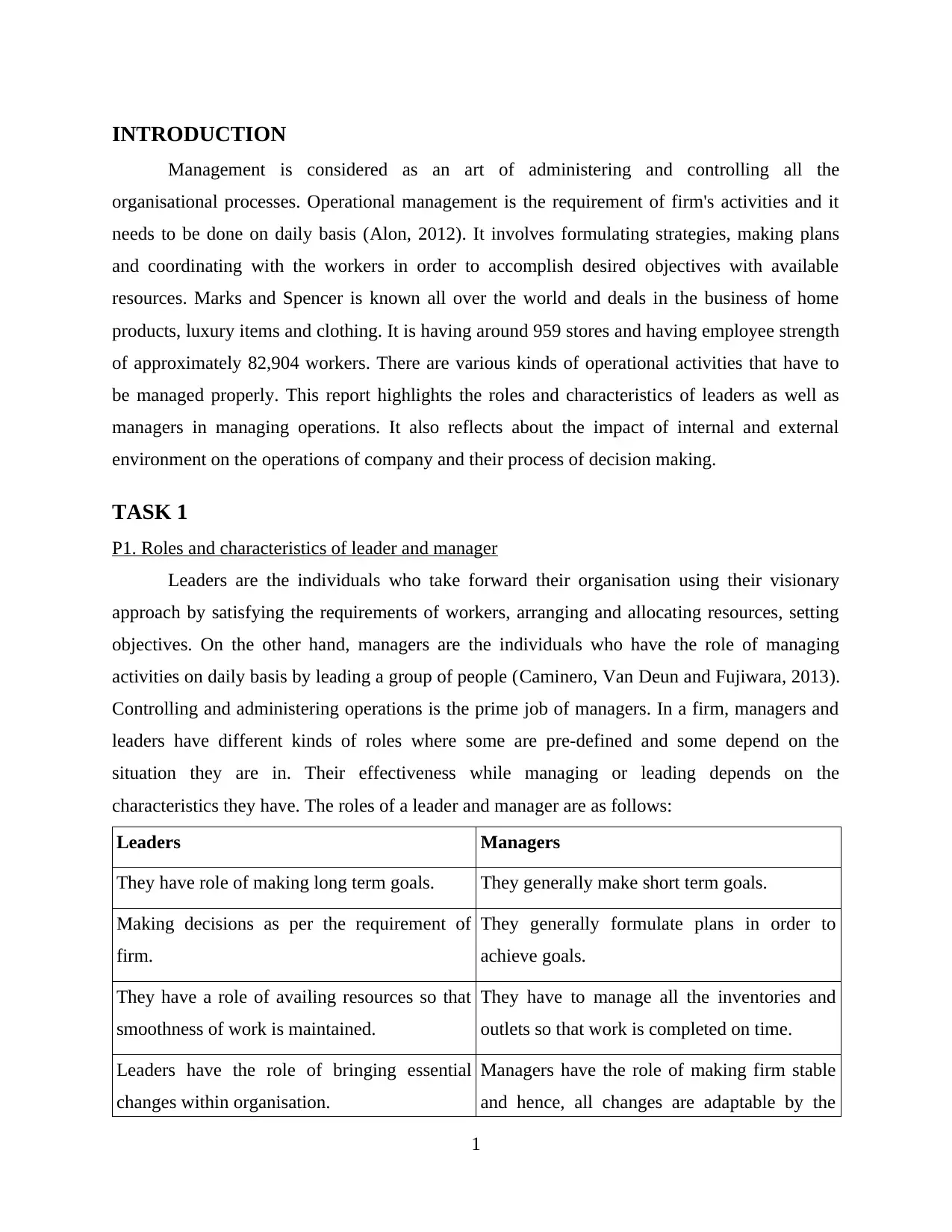
INTRODUCTION
Management is considered as an art of administering and controlling all the
organisational processes. Operational management is the requirement of firm's activities and it
needs to be done on daily basis (Alon, 2012). It involves formulating strategies, making plans
and coordinating with the workers in order to accomplish desired objectives with available
resources. Marks and Spencer is known all over the world and deals in the business of home
products, luxury items and clothing. It is having around 959 stores and having employee strength
of approximately 82,904 workers. There are various kinds of operational activities that have to
be managed properly. This report highlights the roles and characteristics of leaders as well as
managers in managing operations. It also reflects about the impact of internal and external
environment on the operations of company and their process of decision making.
TASK 1
P1. Roles and characteristics of leader and manager
Leaders are the individuals who take forward their organisation using their visionary
approach by satisfying the requirements of workers, arranging and allocating resources, setting
objectives. On the other hand, managers are the individuals who have the role of managing
activities on daily basis by leading a group of people (Caminero, Van Deun and Fujiwara, 2013).
Controlling and administering operations is the prime job of managers. In a firm, managers and
leaders have different kinds of roles where some are pre-defined and some depend on the
situation they are in. Their effectiveness while managing or leading depends on the
characteristics they have. The roles of a leader and manager are as follows:
Leaders Managers
They have role of making long term goals. They generally make short term goals.
Making decisions as per the requirement of
firm.
They generally formulate plans in order to
achieve goals.
They have a role of availing resources so that
smoothness of work is maintained.
They have to manage all the inventories and
outlets so that work is completed on time.
Leaders have the role of bringing essential
changes within organisation.
Managers have the role of making firm stable
and hence, all changes are adaptable by the
1
Management is considered as an art of administering and controlling all the
organisational processes. Operational management is the requirement of firm's activities and it
needs to be done on daily basis (Alon, 2012). It involves formulating strategies, making plans
and coordinating with the workers in order to accomplish desired objectives with available
resources. Marks and Spencer is known all over the world and deals in the business of home
products, luxury items and clothing. It is having around 959 stores and having employee strength
of approximately 82,904 workers. There are various kinds of operational activities that have to
be managed properly. This report highlights the roles and characteristics of leaders as well as
managers in managing operations. It also reflects about the impact of internal and external
environment on the operations of company and their process of decision making.
TASK 1
P1. Roles and characteristics of leader and manager
Leaders are the individuals who take forward their organisation using their visionary
approach by satisfying the requirements of workers, arranging and allocating resources, setting
objectives. On the other hand, managers are the individuals who have the role of managing
activities on daily basis by leading a group of people (Caminero, Van Deun and Fujiwara, 2013).
Controlling and administering operations is the prime job of managers. In a firm, managers and
leaders have different kinds of roles where some are pre-defined and some depend on the
situation they are in. Their effectiveness while managing or leading depends on the
characteristics they have. The roles of a leader and manager are as follows:
Leaders Managers
They have role of making long term goals. They generally make short term goals.
Making decisions as per the requirement of
firm.
They generally formulate plans in order to
achieve goals.
They have a role of availing resources so that
smoothness of work is maintained.
They have to manage all the inventories and
outlets so that work is completed on time.
Leaders have the role of bringing essential
changes within organisation.
Managers have the role of making firm stable
and hence, all changes are adaptable by the
1
Paraphrase This Document
Need a fresh take? Get an instant paraphrase of this document with our AI Paraphraser
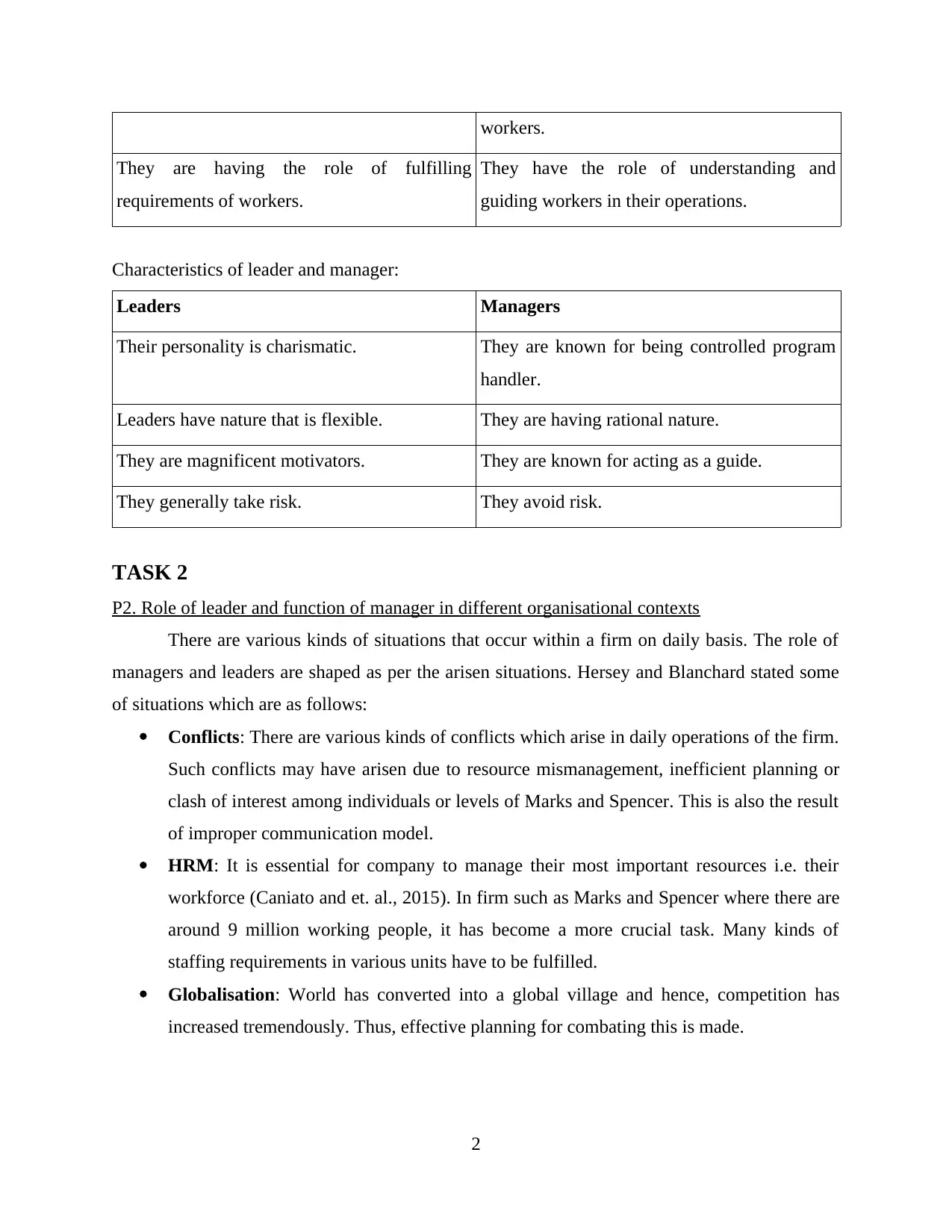
workers.
They are having the role of fulfilling
requirements of workers.
They have the role of understanding and
guiding workers in their operations.
Characteristics of leader and manager:
Leaders Managers
Their personality is charismatic. They are known for being controlled program
handler.
Leaders have nature that is flexible. They are having rational nature.
They are magnificent motivators. They are known for acting as a guide.
They generally take risk. They avoid risk.
TASK 2
P2. Role of leader and function of manager in different organisational contexts
There are various kinds of situations that occur within a firm on daily basis. The role of
managers and leaders are shaped as per the arisen situations. Hersey and Blanchard stated some
of situations which are as follows:
Conflicts: There are various kinds of conflicts which arise in daily operations of the firm.
Such conflicts may have arisen due to resource mismanagement, inefficient planning or
clash of interest among individuals or levels of Marks and Spencer. This is also the result
of improper communication model.
HRM: It is essential for company to manage their most important resources i.e. their
workforce (Caniato and et. al., 2015). In firm such as Marks and Spencer where there are
around 9 million working people, it has become a more crucial task. Many kinds of
staffing requirements in various units have to be fulfilled.
Globalisation: World has converted into a global village and hence, competition has
increased tremendously. Thus, effective planning for combating this is made.
2
They are having the role of fulfilling
requirements of workers.
They have the role of understanding and
guiding workers in their operations.
Characteristics of leader and manager:
Leaders Managers
Their personality is charismatic. They are known for being controlled program
handler.
Leaders have nature that is flexible. They are having rational nature.
They are magnificent motivators. They are known for acting as a guide.
They generally take risk. They avoid risk.
TASK 2
P2. Role of leader and function of manager in different organisational contexts
There are various kinds of situations that occur within a firm on daily basis. The role of
managers and leaders are shaped as per the arisen situations. Hersey and Blanchard stated some
of situations which are as follows:
Conflicts: There are various kinds of conflicts which arise in daily operations of the firm.
Such conflicts may have arisen due to resource mismanagement, inefficient planning or
clash of interest among individuals or levels of Marks and Spencer. This is also the result
of improper communication model.
HRM: It is essential for company to manage their most important resources i.e. their
workforce (Caniato and et. al., 2015). In firm such as Marks and Spencer where there are
around 9 million working people, it has become a more crucial task. Many kinds of
staffing requirements in various units have to be fulfilled.
Globalisation: World has converted into a global village and hence, competition has
increased tremendously. Thus, effective planning for combating this is made.
2
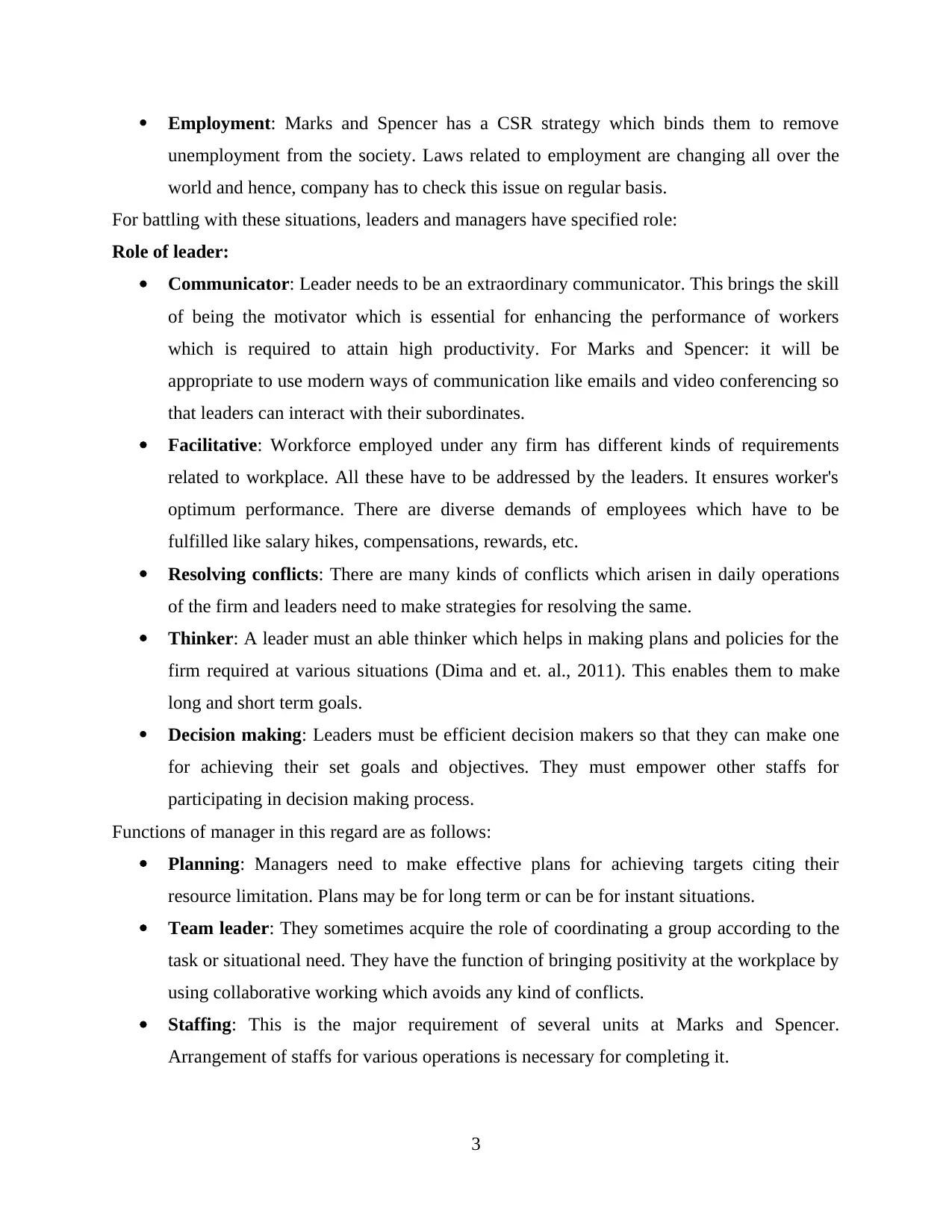
Employment: Marks and Spencer has a CSR strategy which binds them to remove
unemployment from the society. Laws related to employment are changing all over the
world and hence, company has to check this issue on regular basis.
For battling with these situations, leaders and managers have specified role:
Role of leader:
Communicator: Leader needs to be an extraordinary communicator. This brings the skill
of being the motivator which is essential for enhancing the performance of workers
which is required to attain high productivity. For Marks and Spencer: it will be
appropriate to use modern ways of communication like emails and video conferencing so
that leaders can interact with their subordinates.
Facilitative: Workforce employed under any firm has different kinds of requirements
related to workplace. All these have to be addressed by the leaders. It ensures worker's
optimum performance. There are diverse demands of employees which have to be
fulfilled like salary hikes, compensations, rewards, etc.
Resolving conflicts: There are many kinds of conflicts which arisen in daily operations
of the firm and leaders need to make strategies for resolving the same.
Thinker: A leader must an able thinker which helps in making plans and policies for the
firm required at various situations (Dima and et. al., 2011). This enables them to make
long and short term goals.
Decision making: Leaders must be efficient decision makers so that they can make one
for achieving their set goals and objectives. They must empower other staffs for
participating in decision making process.
Functions of manager in this regard are as follows:
Planning: Managers need to make effective plans for achieving targets citing their
resource limitation. Plans may be for long term or can be for instant situations.
Team leader: They sometimes acquire the role of coordinating a group according to the
task or situational need. They have the function of bringing positivity at the workplace by
using collaborative working which avoids any kind of conflicts.
Staffing: This is the major requirement of several units at Marks and Spencer.
Arrangement of staffs for various operations is necessary for completing it.
3
unemployment from the society. Laws related to employment are changing all over the
world and hence, company has to check this issue on regular basis.
For battling with these situations, leaders and managers have specified role:
Role of leader:
Communicator: Leader needs to be an extraordinary communicator. This brings the skill
of being the motivator which is essential for enhancing the performance of workers
which is required to attain high productivity. For Marks and Spencer: it will be
appropriate to use modern ways of communication like emails and video conferencing so
that leaders can interact with their subordinates.
Facilitative: Workforce employed under any firm has different kinds of requirements
related to workplace. All these have to be addressed by the leaders. It ensures worker's
optimum performance. There are diverse demands of employees which have to be
fulfilled like salary hikes, compensations, rewards, etc.
Resolving conflicts: There are many kinds of conflicts which arisen in daily operations
of the firm and leaders need to make strategies for resolving the same.
Thinker: A leader must an able thinker which helps in making plans and policies for the
firm required at various situations (Dima and et. al., 2011). This enables them to make
long and short term goals.
Decision making: Leaders must be efficient decision makers so that they can make one
for achieving their set goals and objectives. They must empower other staffs for
participating in decision making process.
Functions of manager in this regard are as follows:
Planning: Managers need to make effective plans for achieving targets citing their
resource limitation. Plans may be for long term or can be for instant situations.
Team leader: They sometimes acquire the role of coordinating a group according to the
task or situational need. They have the function of bringing positivity at the workplace by
using collaborative working which avoids any kind of conflicts.
Staffing: This is the major requirement of several units at Marks and Spencer.
Arrangement of staffs for various operations is necessary for completing it.
3
⊘ This is a preview!⊘
Do you want full access?
Subscribe today to unlock all pages.

Trusted by 1+ million students worldwide
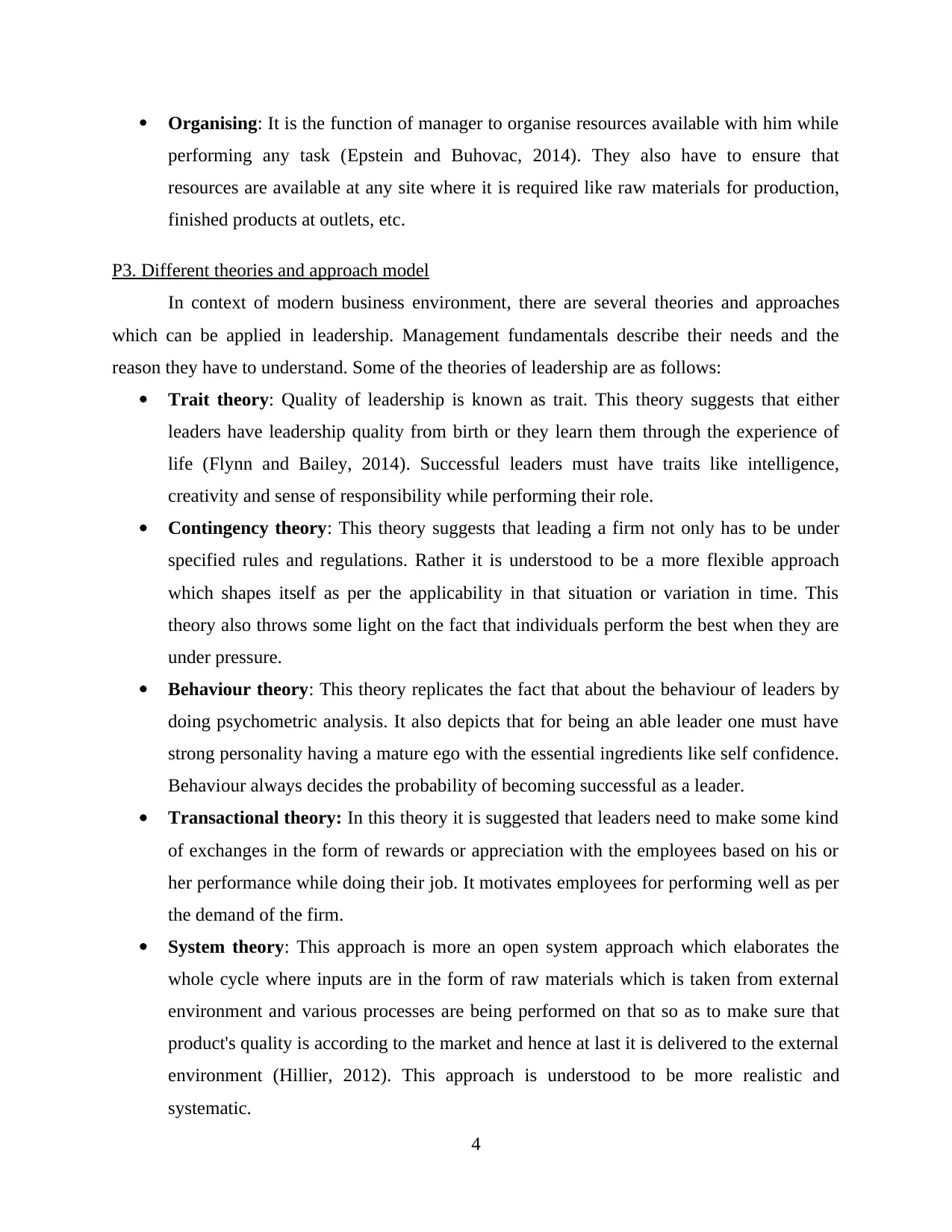
Organising: It is the function of manager to organise resources available with him while
performing any task (Epstein and Buhovac, 2014). They also have to ensure that
resources are available at any site where it is required like raw materials for production,
finished products at outlets, etc.
P3. Different theories and approach model
In context of modern business environment, there are several theories and approaches
which can be applied in leadership. Management fundamentals describe their needs and the
reason they have to understand. Some of the theories of leadership are as follows:
Trait theory: Quality of leadership is known as trait. This theory suggests that either
leaders have leadership quality from birth or they learn them through the experience of
life (Flynn and Bailey, 2014). Successful leaders must have traits like intelligence,
creativity and sense of responsibility while performing their role.
Contingency theory: This theory suggests that leading a firm not only has to be under
specified rules and regulations. Rather it is understood to be a more flexible approach
which shapes itself as per the applicability in that situation or variation in time. This
theory also throws some light on the fact that individuals perform the best when they are
under pressure.
Behaviour theory: This theory replicates the fact that about the behaviour of leaders by
doing psychometric analysis. It also depicts that for being an able leader one must have
strong personality having a mature ego with the essential ingredients like self confidence.
Behaviour always decides the probability of becoming successful as a leader.
Transactional theory: In this theory it is suggested that leaders need to make some kind
of exchanges in the form of rewards or appreciation with the employees based on his or
her performance while doing their job. It motivates employees for performing well as per
the demand of the firm.
System theory: This approach is more an open system approach which elaborates the
whole cycle where inputs are in the form of raw materials which is taken from external
environment and various processes are being performed on that so as to make sure that
product's quality is according to the market and hence at last it is delivered to the external
environment (Hillier, 2012). This approach is understood to be more realistic and
systematic.
4
performing any task (Epstein and Buhovac, 2014). They also have to ensure that
resources are available at any site where it is required like raw materials for production,
finished products at outlets, etc.
P3. Different theories and approach model
In context of modern business environment, there are several theories and approaches
which can be applied in leadership. Management fundamentals describe their needs and the
reason they have to understand. Some of the theories of leadership are as follows:
Trait theory: Quality of leadership is known as trait. This theory suggests that either
leaders have leadership quality from birth or they learn them through the experience of
life (Flynn and Bailey, 2014). Successful leaders must have traits like intelligence,
creativity and sense of responsibility while performing their role.
Contingency theory: This theory suggests that leading a firm not only has to be under
specified rules and regulations. Rather it is understood to be a more flexible approach
which shapes itself as per the applicability in that situation or variation in time. This
theory also throws some light on the fact that individuals perform the best when they are
under pressure.
Behaviour theory: This theory replicates the fact that about the behaviour of leaders by
doing psychometric analysis. It also depicts that for being an able leader one must have
strong personality having a mature ego with the essential ingredients like self confidence.
Behaviour always decides the probability of becoming successful as a leader.
Transactional theory: In this theory it is suggested that leaders need to make some kind
of exchanges in the form of rewards or appreciation with the employees based on his or
her performance while doing their job. It motivates employees for performing well as per
the demand of the firm.
System theory: This approach is more an open system approach which elaborates the
whole cycle where inputs are in the form of raw materials which is taken from external
environment and various processes are being performed on that so as to make sure that
product's quality is according to the market and hence at last it is delivered to the external
environment (Hillier, 2012). This approach is understood to be more realistic and
systematic.
4
Paraphrase This Document
Need a fresh take? Get an instant paraphrase of this document with our AI Paraphraser
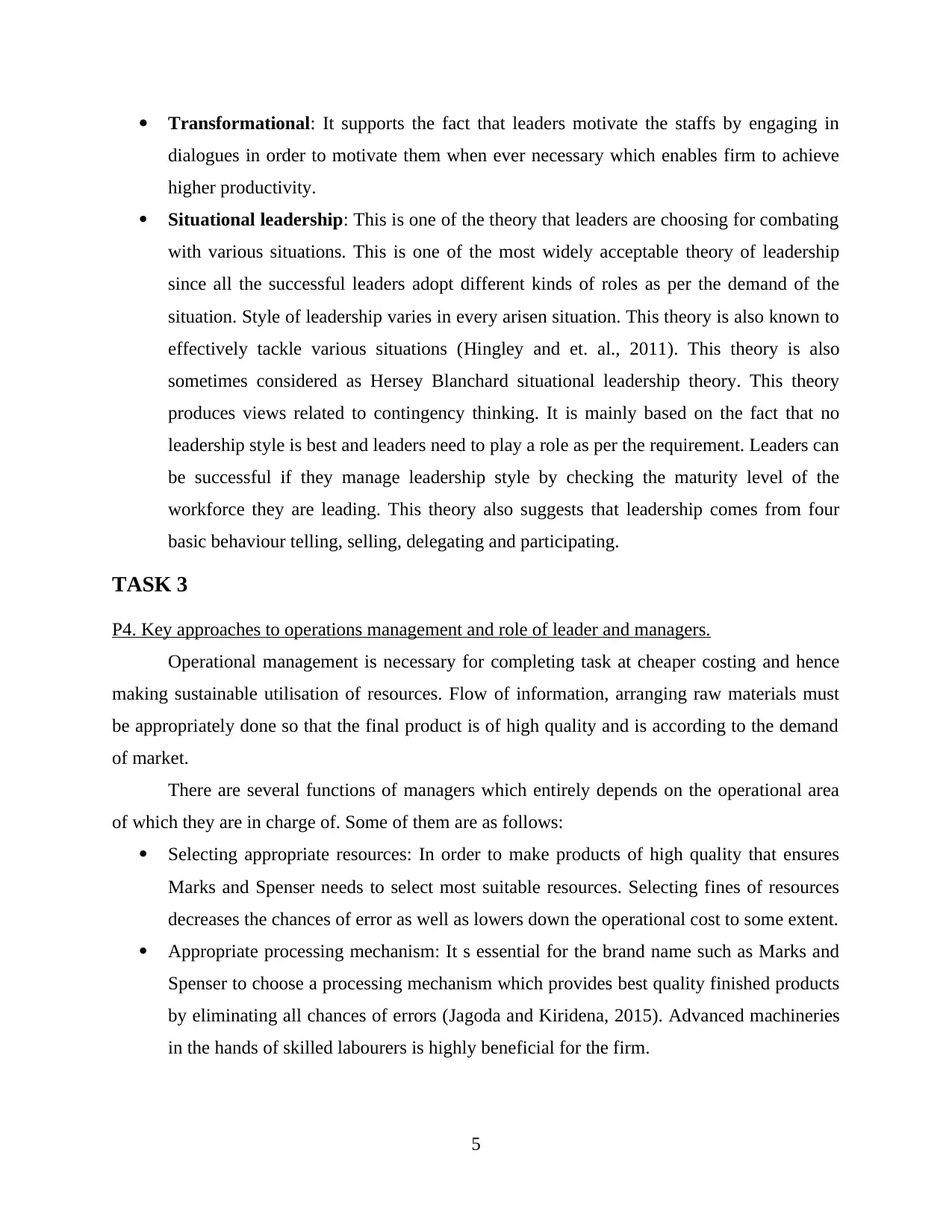
Transformational: It supports the fact that leaders motivate the staffs by engaging in
dialogues in order to motivate them when ever necessary which enables firm to achieve
higher productivity.
Situational leadership: This is one of the theory that leaders are choosing for combating
with various situations. This is one of the most widely acceptable theory of leadership
since all the successful leaders adopt different kinds of roles as per the demand of the
situation. Style of leadership varies in every arisen situation. This theory is also known to
effectively tackle various situations (Hingley and et. al., 2011). This theory is also
sometimes considered as Hersey Blanchard situational leadership theory. This theory
produces views related to contingency thinking. It is mainly based on the fact that no
leadership style is best and leaders need to play a role as per the requirement. Leaders can
be successful if they manage leadership style by checking the maturity level of the
workforce they are leading. This theory also suggests that leadership comes from four
basic behaviour telling, selling, delegating and participating.
TASK 3
P4. Key approaches to operations management and role of leader and managers.
Operational management is necessary for completing task at cheaper costing and hence
making sustainable utilisation of resources. Flow of information, arranging raw materials must
be appropriately done so that the final product is of high quality and is according to the demand
of market.
There are several functions of managers which entirely depends on the operational area
of which they are in charge of. Some of them are as follows:
Selecting appropriate resources: In order to make products of high quality that ensures
Marks and Spenser needs to select most suitable resources. Selecting fines of resources
decreases the chances of error as well as lowers down the operational cost to some extent.
Appropriate processing mechanism: It s essential for the brand name such as Marks and
Spenser to choose a processing mechanism which provides best quality finished products
by eliminating all chances of errors (Jagoda and Kiridena, 2015). Advanced machineries
in the hands of skilled labourers is highly beneficial for the firm.
5
dialogues in order to motivate them when ever necessary which enables firm to achieve
higher productivity.
Situational leadership: This is one of the theory that leaders are choosing for combating
with various situations. This is one of the most widely acceptable theory of leadership
since all the successful leaders adopt different kinds of roles as per the demand of the
situation. Style of leadership varies in every arisen situation. This theory is also known to
effectively tackle various situations (Hingley and et. al., 2011). This theory is also
sometimes considered as Hersey Blanchard situational leadership theory. This theory
produces views related to contingency thinking. It is mainly based on the fact that no
leadership style is best and leaders need to play a role as per the requirement. Leaders can
be successful if they manage leadership style by checking the maturity level of the
workforce they are leading. This theory also suggests that leadership comes from four
basic behaviour telling, selling, delegating and participating.
TASK 3
P4. Key approaches to operations management and role of leader and managers.
Operational management is necessary for completing task at cheaper costing and hence
making sustainable utilisation of resources. Flow of information, arranging raw materials must
be appropriately done so that the final product is of high quality and is according to the demand
of market.
There are several functions of managers which entirely depends on the operational area
of which they are in charge of. Some of them are as follows:
Selecting appropriate resources: In order to make products of high quality that ensures
Marks and Spenser needs to select most suitable resources. Selecting fines of resources
decreases the chances of error as well as lowers down the operational cost to some extent.
Appropriate processing mechanism: It s essential for the brand name such as Marks and
Spenser to choose a processing mechanism which provides best quality finished products
by eliminating all chances of errors (Jagoda and Kiridena, 2015). Advanced machineries
in the hands of skilled labourers is highly beneficial for the firm.
5
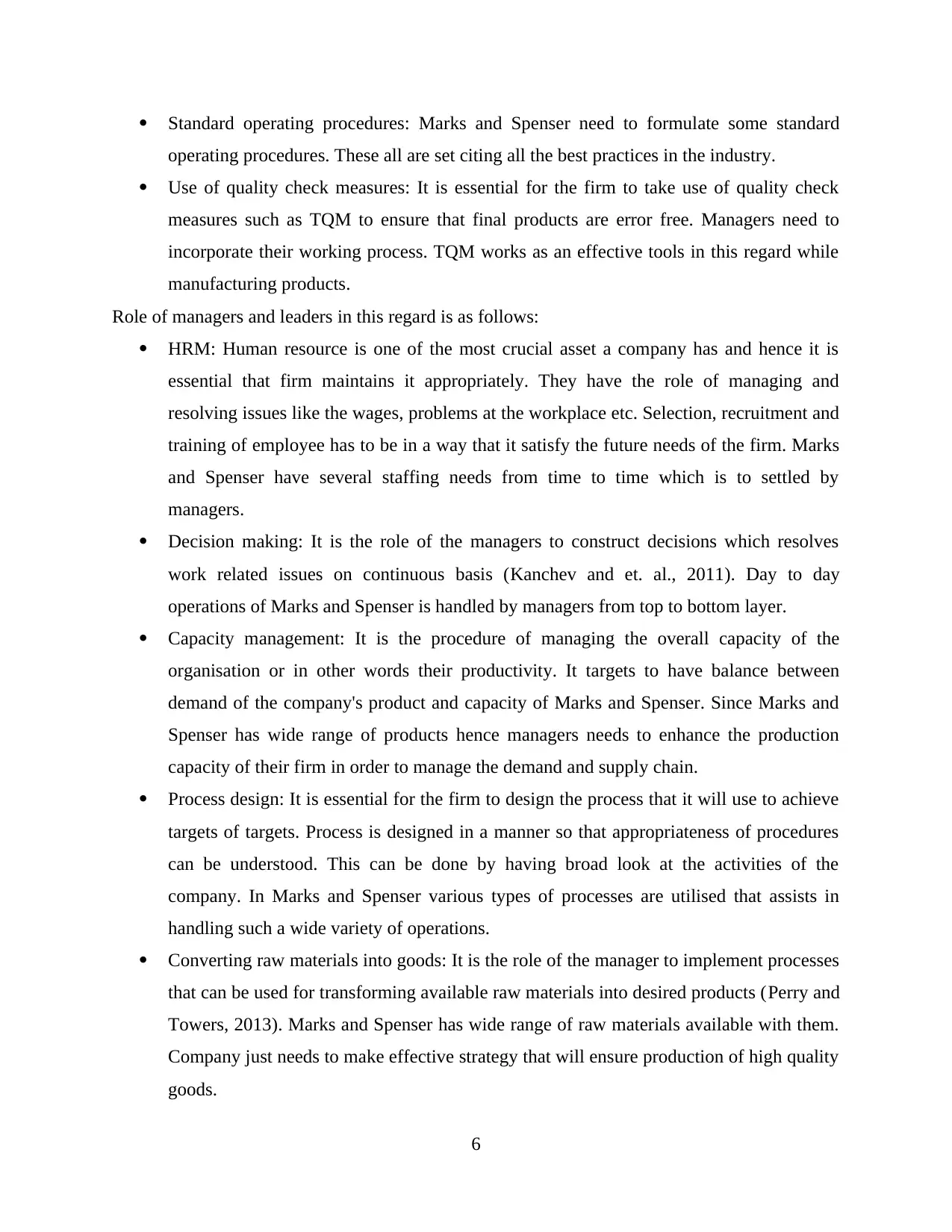
Standard operating procedures: Marks and Spenser need to formulate some standard
operating procedures. These all are set citing all the best practices in the industry.
Use of quality check measures: It is essential for the firm to take use of quality check
measures such as TQM to ensure that final products are error free. Managers need to
incorporate their working process. TQM works as an effective tools in this regard while
manufacturing products.
Role of managers and leaders in this regard is as follows:
HRM: Human resource is one of the most crucial asset a company has and hence it is
essential that firm maintains it appropriately. They have the role of managing and
resolving issues like the wages, problems at the workplace etc. Selection, recruitment and
training of employee has to be in a way that it satisfy the future needs of the firm. Marks
and Spenser have several staffing needs from time to time which is to settled by
managers.
Decision making: It is the role of the managers to construct decisions which resolves
work related issues on continuous basis (Kanchev and et. al., 2011). Day to day
operations of Marks and Spenser is handled by managers from top to bottom layer.
Capacity management: It is the procedure of managing the overall capacity of the
organisation or in other words their productivity. It targets to have balance between
demand of the company's product and capacity of Marks and Spenser. Since Marks and
Spenser has wide range of products hence managers needs to enhance the production
capacity of their firm in order to manage the demand and supply chain.
Process design: It is essential for the firm to design the process that it will use to achieve
targets of targets. Process is designed in a manner so that appropriateness of procedures
can be understood. This can be done by having broad look at the activities of the
company. In Marks and Spenser various types of processes are utilised that assists in
handling such a wide variety of operations.
Converting raw materials into goods: It is the role of the manager to implement processes
that can be used for transforming available raw materials into desired products (Perry and
Towers, 2013). Marks and Spenser has wide range of raw materials available with them.
Company just needs to make effective strategy that will ensure production of high quality
goods.
6
operating procedures. These all are set citing all the best practices in the industry.
Use of quality check measures: It is essential for the firm to take use of quality check
measures such as TQM to ensure that final products are error free. Managers need to
incorporate their working process. TQM works as an effective tools in this regard while
manufacturing products.
Role of managers and leaders in this regard is as follows:
HRM: Human resource is one of the most crucial asset a company has and hence it is
essential that firm maintains it appropriately. They have the role of managing and
resolving issues like the wages, problems at the workplace etc. Selection, recruitment and
training of employee has to be in a way that it satisfy the future needs of the firm. Marks
and Spenser have several staffing needs from time to time which is to settled by
managers.
Decision making: It is the role of the managers to construct decisions which resolves
work related issues on continuous basis (Kanchev and et. al., 2011). Day to day
operations of Marks and Spenser is handled by managers from top to bottom layer.
Capacity management: It is the procedure of managing the overall capacity of the
organisation or in other words their productivity. It targets to have balance between
demand of the company's product and capacity of Marks and Spenser. Since Marks and
Spenser has wide range of products hence managers needs to enhance the production
capacity of their firm in order to manage the demand and supply chain.
Process design: It is essential for the firm to design the process that it will use to achieve
targets of targets. Process is designed in a manner so that appropriateness of procedures
can be understood. This can be done by having broad look at the activities of the
company. In Marks and Spenser various types of processes are utilised that assists in
handling such a wide variety of operations.
Converting raw materials into goods: It is the role of the manager to implement processes
that can be used for transforming available raw materials into desired products (Perry and
Towers, 2013). Marks and Spenser has wide range of raw materials available with them.
Company just needs to make effective strategy that will ensure production of high quality
goods.
6
⊘ This is a preview!⊘
Do you want full access?
Subscribe today to unlock all pages.

Trusted by 1+ million students worldwide
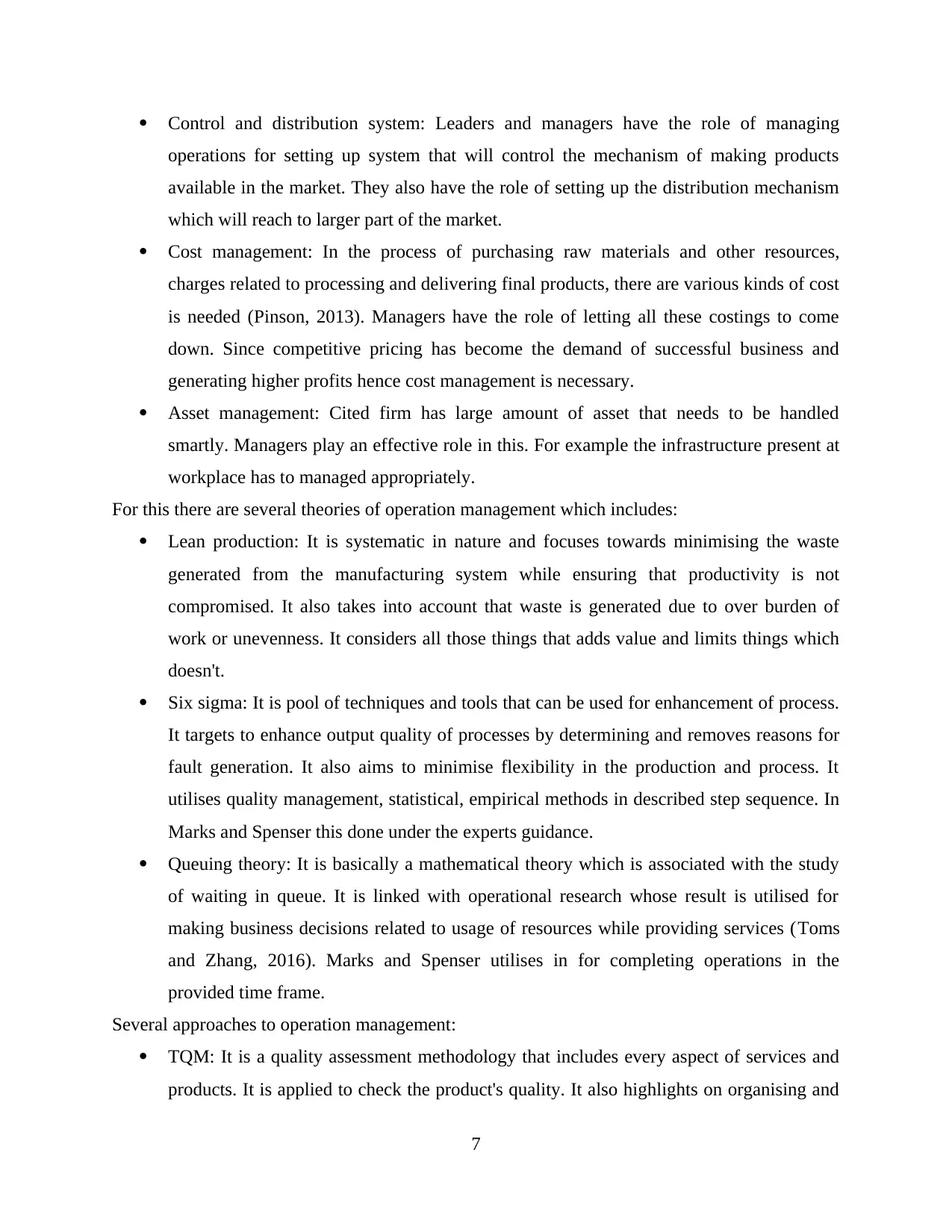
Control and distribution system: Leaders and managers have the role of managing
operations for setting up system that will control the mechanism of making products
available in the market. They also have the role of setting up the distribution mechanism
which will reach to larger part of the market.
Cost management: In the process of purchasing raw materials and other resources,
charges related to processing and delivering final products, there are various kinds of cost
is needed (Pinson, 2013). Managers have the role of letting all these costings to come
down. Since competitive pricing has become the demand of successful business and
generating higher profits hence cost management is necessary.
Asset management: Cited firm has large amount of asset that needs to be handled
smartly. Managers play an effective role in this. For example the infrastructure present at
workplace has to managed appropriately.
For this there are several theories of operation management which includes:
Lean production: It is systematic in nature and focuses towards minimising the waste
generated from the manufacturing system while ensuring that productivity is not
compromised. It also takes into account that waste is generated due to over burden of
work or unevenness. It considers all those things that adds value and limits things which
doesn't.
Six sigma: It is pool of techniques and tools that can be used for enhancement of process.
It targets to enhance output quality of processes by determining and removes reasons for
fault generation. It also aims to minimise flexibility in the production and process. It
utilises quality management, statistical, empirical methods in described step sequence. In
Marks and Spenser this done under the experts guidance.
Queuing theory: It is basically a mathematical theory which is associated with the study
of waiting in queue. It is linked with operational research whose result is utilised for
making business decisions related to usage of resources while providing services (Toms
and Zhang, 2016). Marks and Spenser utilises in for completing operations in the
provided time frame.
Several approaches to operation management:
TQM: It is a quality assessment methodology that includes every aspect of services and
products. It is applied to check the product's quality. It also highlights on organising and
7
operations for setting up system that will control the mechanism of making products
available in the market. They also have the role of setting up the distribution mechanism
which will reach to larger part of the market.
Cost management: In the process of purchasing raw materials and other resources,
charges related to processing and delivering final products, there are various kinds of cost
is needed (Pinson, 2013). Managers have the role of letting all these costings to come
down. Since competitive pricing has become the demand of successful business and
generating higher profits hence cost management is necessary.
Asset management: Cited firm has large amount of asset that needs to be handled
smartly. Managers play an effective role in this. For example the infrastructure present at
workplace has to managed appropriately.
For this there are several theories of operation management which includes:
Lean production: It is systematic in nature and focuses towards minimising the waste
generated from the manufacturing system while ensuring that productivity is not
compromised. It also takes into account that waste is generated due to over burden of
work or unevenness. It considers all those things that adds value and limits things which
doesn't.
Six sigma: It is pool of techniques and tools that can be used for enhancement of process.
It targets to enhance output quality of processes by determining and removes reasons for
fault generation. It also aims to minimise flexibility in the production and process. It
utilises quality management, statistical, empirical methods in described step sequence. In
Marks and Spenser this done under the experts guidance.
Queuing theory: It is basically a mathematical theory which is associated with the study
of waiting in queue. It is linked with operational research whose result is utilised for
making business decisions related to usage of resources while providing services (Toms
and Zhang, 2016). Marks and Spenser utilises in for completing operations in the
provided time frame.
Several approaches to operation management:
TQM: It is a quality assessment methodology that includes every aspect of services and
products. It is applied to check the product's quality. It also highlights on organising and
7
Paraphrase This Document
Need a fresh take? Get an instant paraphrase of this document with our AI Paraphraser
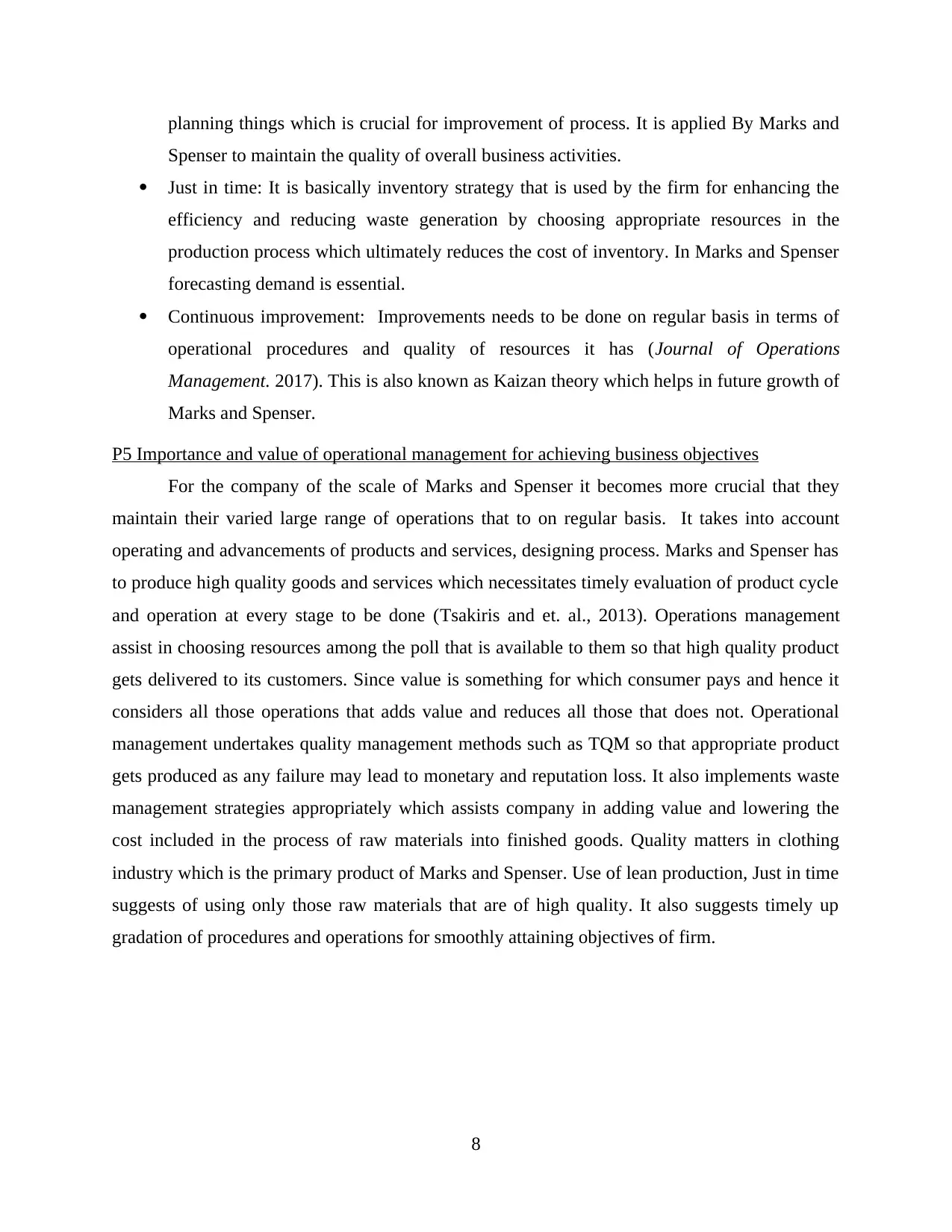
planning things which is crucial for improvement of process. It is applied By Marks and
Spenser to maintain the quality of overall business activities.
Just in time: It is basically inventory strategy that is used by the firm for enhancing the
efficiency and reducing waste generation by choosing appropriate resources in the
production process which ultimately reduces the cost of inventory. In Marks and Spenser
forecasting demand is essential.
Continuous improvement: Improvements needs to be done on regular basis in terms of
operational procedures and quality of resources it has (Journal of Operations
Management. 2017). This is also known as Kaizan theory which helps in future growth of
Marks and Spenser.
P5 Importance and value of operational management for achieving business objectives
For the company of the scale of Marks and Spenser it becomes more crucial that they
maintain their varied large range of operations that to on regular basis. It takes into account
operating and advancements of products and services, designing process. Marks and Spenser has
to produce high quality goods and services which necessitates timely evaluation of product cycle
and operation at every stage to be done (Tsakiris and et. al., 2013). Operations management
assist in choosing resources among the poll that is available to them so that high quality product
gets delivered to its customers. Since value is something for which consumer pays and hence it
considers all those operations that adds value and reduces all those that does not. Operational
management undertakes quality management methods such as TQM so that appropriate product
gets produced as any failure may lead to monetary and reputation loss. It also implements waste
management strategies appropriately which assists company in adding value and lowering the
cost included in the process of raw materials into finished goods. Quality matters in clothing
industry which is the primary product of Marks and Spenser. Use of lean production, Just in time
suggests of using only those raw materials that are of high quality. It also suggests timely up
gradation of procedures and operations for smoothly attaining objectives of firm.
8
Spenser to maintain the quality of overall business activities.
Just in time: It is basically inventory strategy that is used by the firm for enhancing the
efficiency and reducing waste generation by choosing appropriate resources in the
production process which ultimately reduces the cost of inventory. In Marks and Spenser
forecasting demand is essential.
Continuous improvement: Improvements needs to be done on regular basis in terms of
operational procedures and quality of resources it has (Journal of Operations
Management. 2017). This is also known as Kaizan theory which helps in future growth of
Marks and Spenser.
P5 Importance and value of operational management for achieving business objectives
For the company of the scale of Marks and Spenser it becomes more crucial that they
maintain their varied large range of operations that to on regular basis. It takes into account
operating and advancements of products and services, designing process. Marks and Spenser has
to produce high quality goods and services which necessitates timely evaluation of product cycle
and operation at every stage to be done (Tsakiris and et. al., 2013). Operations management
assist in choosing resources among the poll that is available to them so that high quality product
gets delivered to its customers. Since value is something for which consumer pays and hence it
considers all those operations that adds value and reduces all those that does not. Operational
management undertakes quality management methods such as TQM so that appropriate product
gets produced as any failure may lead to monetary and reputation loss. It also implements waste
management strategies appropriately which assists company in adding value and lowering the
cost included in the process of raw materials into finished goods. Quality matters in clothing
industry which is the primary product of Marks and Spenser. Use of lean production, Just in time
suggests of using only those raw materials that are of high quality. It also suggests timely up
gradation of procedures and operations for smoothly attaining objectives of firm.
8
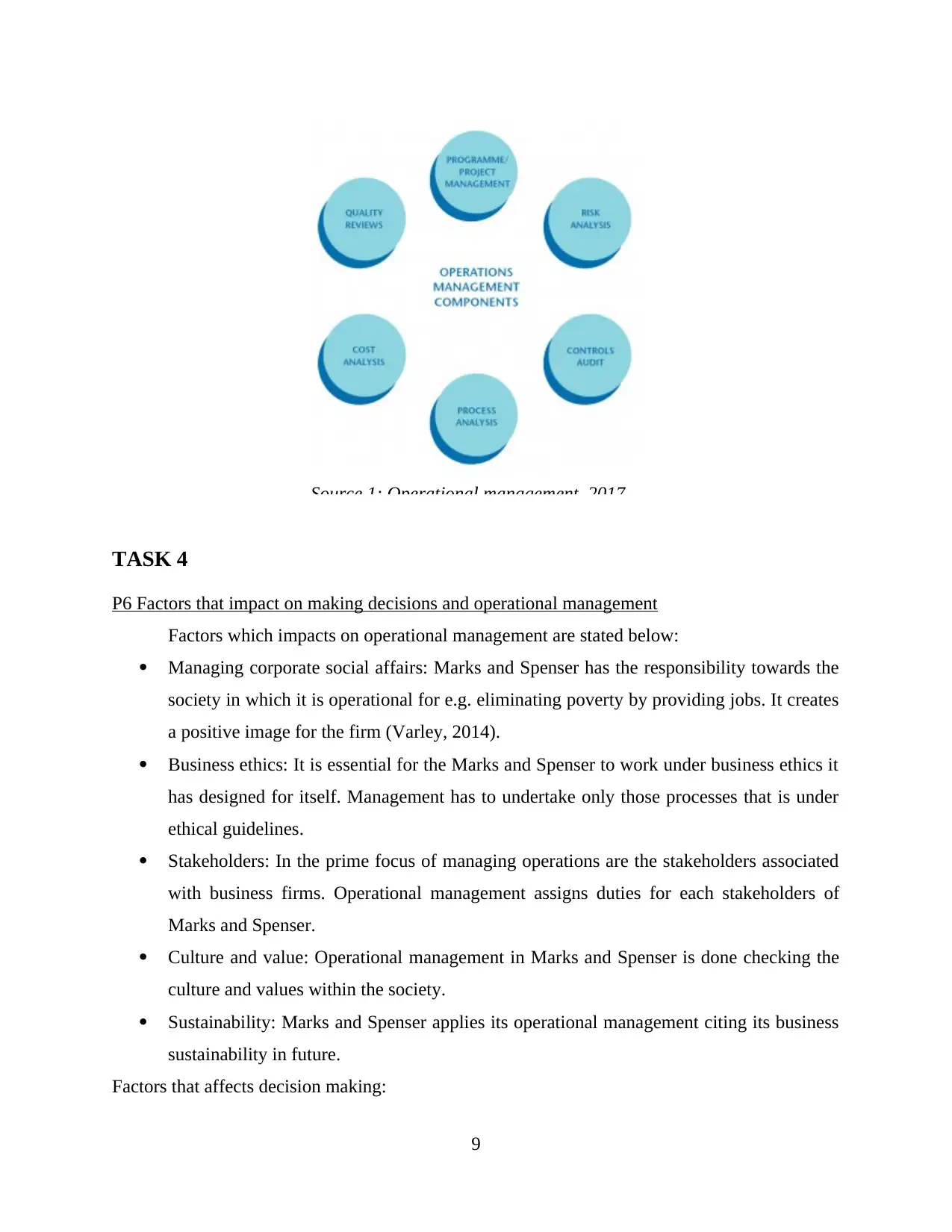
TASK 4
P6 Factors that impact on making decisions and operational management
Factors which impacts on operational management are stated below:
Managing corporate social affairs: Marks and Spenser has the responsibility towards the
society in which it is operational for e.g. eliminating poverty by providing jobs. It creates
a positive image for the firm (Varley, 2014).
Business ethics: It is essential for the Marks and Spenser to work under business ethics it
has designed for itself. Management has to undertake only those processes that is under
ethical guidelines.
Stakeholders: In the prime focus of managing operations are the stakeholders associated
with business firms. Operational management assigns duties for each stakeholders of
Marks and Spenser.
Culture and value: Operational management in Marks and Spenser is done checking the
culture and values within the society.
Sustainability: Marks and Spenser applies its operational management citing its business
sustainability in future.
Factors that affects decision making:
9
Source 1: Operational management, 2017
P6 Factors that impact on making decisions and operational management
Factors which impacts on operational management are stated below:
Managing corporate social affairs: Marks and Spenser has the responsibility towards the
society in which it is operational for e.g. eliminating poverty by providing jobs. It creates
a positive image for the firm (Varley, 2014).
Business ethics: It is essential for the Marks and Spenser to work under business ethics it
has designed for itself. Management has to undertake only those processes that is under
ethical guidelines.
Stakeholders: In the prime focus of managing operations are the stakeholders associated
with business firms. Operational management assigns duties for each stakeholders of
Marks and Spenser.
Culture and value: Operational management in Marks and Spenser is done checking the
culture and values within the society.
Sustainability: Marks and Spenser applies its operational management citing its business
sustainability in future.
Factors that affects decision making:
9
Source 1: Operational management, 2017
⊘ This is a preview!⊘
Do you want full access?
Subscribe today to unlock all pages.

Trusted by 1+ million students worldwide
1 out of 15
Related Documents
Your All-in-One AI-Powered Toolkit for Academic Success.
+13062052269
info@desklib.com
Available 24*7 on WhatsApp / Email
![[object Object]](/_next/static/media/star-bottom.7253800d.svg)
Unlock your academic potential
Copyright © 2020–2025 A2Z Services. All Rights Reserved. Developed and managed by ZUCOL.





